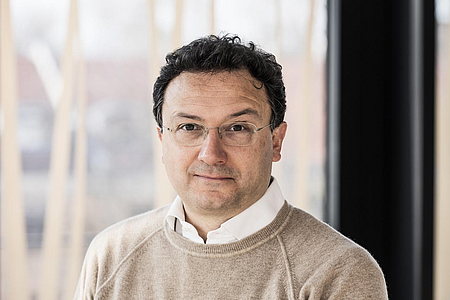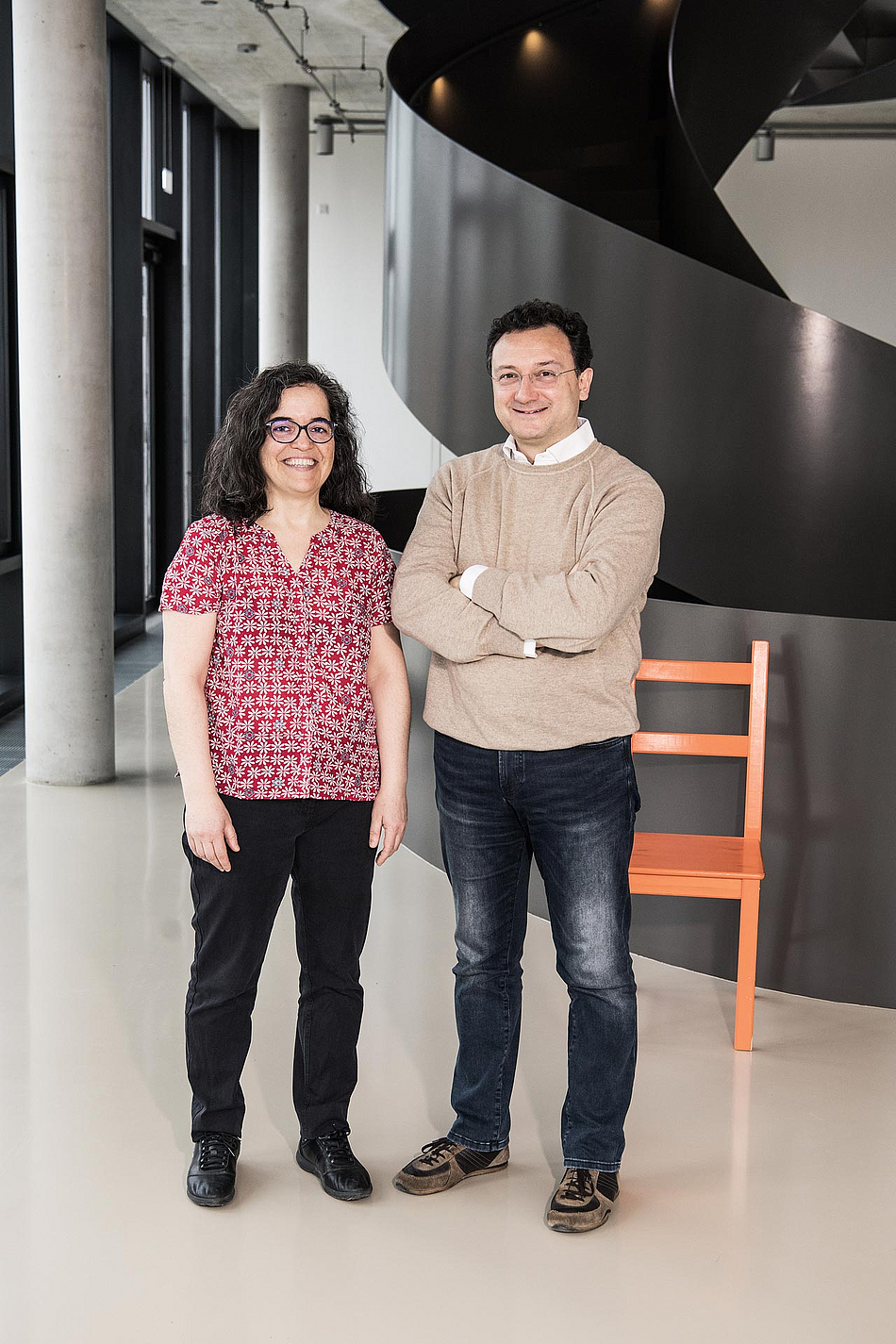The map of our genetic contacts
In an uncoiled state, all of our DNA strands would be about two meters long. It’s therefore easy to grasp that it must be complex to fit the structure of folded chromosomes inside every single cell in our body. The role that this elaborate architecture plays in diseases is being studied by Einstein BIH Visiting Fellow Mario Nicodemi and his host Professor Ana Pombo, in cooperation with the clinical geneticist Professor Stefan Mundlos. We met the former two scientists in Berlin to get a more precise explanation of the architecture of our genome.
In your project description, it says you’re working on a kind of map. Can you give us some idea of what that means?
Nicodemi: I’m studying the 3D structure of the folded chromosomes. Certain areas of the genome are responsible for controlling the genes and the positions of physical contact between these areas of the genome determine, for example, whether the activity of those genes is enhanced or suppressed. With about 20,000 genes in our genome, you can imagine how these contacts may interplay which each other to bring about a complex architecture of chromatin – i.e. the folded packets of DNA. Ana Pombo has developed a technology to show those points of contact. By applying physical laws, I’m trying to understand the underlying molecular mechanisms that control that architecture. Stefan Mundlos is studying how mutations in connection with diseases influence the architecture. Mutations often appear in segments of the genome that do not produce proteins, but nevertheless have a medical effect. We’ve found out that such mutations that do not directly affect genes, often change the contacts between the genes and their regulatory elements elsewhere in the genome, and that certain congenital diseases are connected to that mechanism.
Pombo: To understand how these structures work, we have to look at different states of the cell. We have to observe the cell when it’s at rest, when it’s dividing, when it’s healthy or diseased.
So, due to mutations, gene segments become connected together that weren’t actually supposed to have contact with each other. What effects does this have?
Pombo: Children with birth defects, called congenital diseases, have mutations in their genome that can lead to segments being missing or reorganized. When they consult a clinical geneticist, such as Stefan Mundlos, it is not trivial to guess whether the change in the linear genome sequence has also an impact in the 3D structure of the genome. Mario Nicodemi’s work can make appropriate predictions based on physical laws.
Nicodemi: Different mutations on the same gene locus can be connected to different patterns of disease, such as malformations of the limbs. That can be predicted with our models.
Then your role is to develop the models further?

Funding program
Einstein BIH Visiting Fellows
Funding period
2017 – 2019
Project title
Understanding chromatin folding and gene regulation in disease associated genomic rearrangements
Research area
General genetics
Institution
Max Delbrück Center for Molecular Medicine (MDC)
Since 2015
Coordinator of the National Initiative "Biological Physics", Istituto Nazionale di Fisica Nucleare, Italy
Since 2010
Research Associate, Istituto Nazionale di Fisica Nucleare
Since 2010
Professor of Theoretical Physics, Università degli Studi di Napoli Federico II, Naples, Italy
Nicodemi: The overarching objective is to integrate and explain the high-quality data generated using high-throughput technologies. To this aim, we are developing models by applying the principles of physics. On the one hand, we can better understand fundamental mechanisms of gene regulation, on the other we can expect great benefits for the clinic. Up to now, with Stefan Mundlos we investigated malformations of the skeleton, but our next target is the study of neural developmental disorders as well.
Are the mechanisms involved in the development of neurological and skeletal diseases similar?
Pombo: Different points on the linear genome have different characteristics. There are gene-rich and gene-poor areas. Neural genes are often located in the outer regions of the nucleus during early development; this can influence what happens in that area in the event of a mutation. In the case of the neurological developmental disorder Rett syndrome, the responsible proteins are for example expressed throughout the body, but neurons are particularly susceptible to the mutation. In other cases, a mutation doesn’t lead to any disease at all. We study these complex mechanisms in our models.
Your backgrounds are actually very different. Did you get to know each other by chance?
Pombo: We first met in 2008 – that was by chance. However, despite our different academic backgrounds we quickly discovered that we shared similar ideas as to how and why the 3D structure of the genome could be important.
We began working together on the subject in the UK. Later on, in Berlin, I got to know Stefan Mundlos and other colleagues who have enriched my research enormously. In London, I did not have direct synergies with clinical geneticists. The Einstein BIH Visiting Fellows Program of Stiftung Charité was a great opportunity to establish a closer connection between our laboratories. In this way, a real hub has come into being, centred on the subject of the “nucleome”.
Nicodemi: The interdisciplinary cooperation between a molecular biologist who originally trained as a biochemist, a theoretical physicist and a clinical geneticist is definitely the key to our collaboration. So half a dozen articles in prestigious academic journals have come out of this synergy over the last few years. (laughs)
Your collaboration connects up different disciplines as well as basic research and the clinic. Is this usual nowadays?
Pombo: At the Max Delbrück Center for Molecular Medicine, a guiding principle is that although basic research is essential, good integration in the Berlin research landscape and close collaboration with colleagues at the Charité and at the Berlin Institute of Health are equally important. Berlin is ideal for this exchange. We expect this productive contact to become even easier now that the MDC has opened its new BIMSB building in Mitte.
Nicodemi: At the moment, the flight from Naples to Berlin lasts about as long as the journey from Mitte to the MDC in Buch. (laughs) We have regular meetings and organize joint retreats for our labs, when we spend half a week together and plan different activities. We’ve already met in Berlin, in London and in Naples.
What’s the first thing that springs to mind when you think of your particular laboratory?
Pombo: My team is interdisciplinary and international: we come from ten different countries. The whole troupe is a big adventure, but at the same time they’re also very serious researchers – a mixture of courageous adventurers and at the same time extremely down-to-earth people.
Nicodemi: In my lab, it’s a bit different: we really are nearly all theoretical physicists. You could compare us to the team from the Big Bang Theory, with a great interest in mathematics and computers, but also very open to interdisciplinary collaboration.
Would you want your children to follow in your footsteps and become researchers?
Pombo: If they want that, I wouldn’t try to prevent them. But I wouldn’t tell them what they should do either.
Would you react differently if they wanted to become YouTubers, for example?
Nicodemi: It’s not that far-fetched – my children are very active on YouTube. But if you’re explicitly against it, that only makes it more likely to happen.
Pombo: I totally agree. As a group leader, you’re working with young people at a very exciting time in their lives. Taking care of your own children teaches you certain things that help you to manage a young team. It also works the other way round too. It’s an honour and a great responsibility to accompany young people at this stage of their lives.
Did you feel prepared for such a task? Or is this something one has to grow into?
Pombo: No one is really prepared for it, because there isn’t any preparation. However, there are more and more psychology studies which offer insights about how best to teach and learn. For example, when and how it’s best to teach maths. I’m curious to see how these insights will change teaching in the future.
At German schools, it was often the physics lessons that almost completely failed to interest many pupils…
Nicodemi: The same thing applies in Italy, France, the UK – in fact, everywhere l’ve lived. Of course, it depends on the quality of the teacher concerned. There are people who have a brilliant grasp of physics but are unable to convey it. Other physicists are less brilliant in their field but are better at conveying knowledge. Now and again, you get someone who has both abilities – which is, of course, the ideal scenario.
Have you yourself had any experience with formats that aim to awaken the interest of the broader public in research?
Pombo: At the MDC, there’s the Glass Laboratory, which is almost always booked out and is visited by school groups from all over Germany – it’s fantastic. In other countries, it can be a problem especially if you live away from the bigger scientific centres. That makes it less likely that you’ll have access to such opportunities.
Nicodemi: The less central the area, the less likely it is that people will come into contact with new scientific discoveries. As southern Italy traditionally has a weaker infrastructure than the rich north of the country, programs have been developed in which scientists personally visit the schools in such areas. I’ve participated in this program because I think it’s important to help young people get in contact with novel scientific and technological developments and to draw their attention to the option of a career in frontier science and technology.
What were the best pieces of advice that you yourself received in your scientific career?
Pombo: When I was obtaining my doctorate, I was encouraged to explore at less-known areas of molecular and cellular biology. That way, I had a chance to pursue my own interests and to have a look at new areas.
Nicodemi: It’s important to remember that the level of pressure in a scientific career is extremely high, particularly in the early years. You risk quite a bit and don’t usually have a permanent post for many years. In time, once you’ve proved yourself in the system, it does get easier. For me, following my heart and also taking the odd risk has proved worthwhile.
November 2018 / MM
